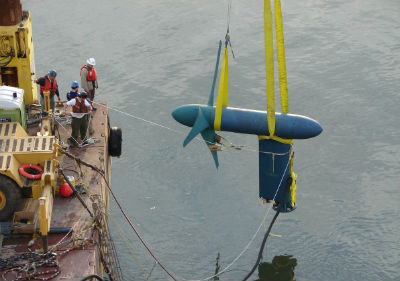WANCHESE — Saltwater is the bane of everything that is metal and moves through the sea, especially when there are mechanical parts involved – such as the gearbox used in offshore wind turbines.
New technology created by engineers at the University of North Carolina Charlotte that uses a magnetic gear box, with no interlocking gears to break and no contacts to rust, could solve the expensive and time-consuming maintenance issues with mechanical devices.
Supporter Spotlight
“It uses the forces of magnetic field to speed up the motion from the ocean and the wind,” Jonathan Bird, an assistant professor of electrical and computer engineering, said in a telephone interview. “In order to generate electricity, you need it to be high speed.”
The gearbox was one of numerous innovative coastal energy projects that were discussed at last month’s UNC’s Coastal Studies Institute’s fourth annual N.C. Renewable Ocean Energy Research Symposium.
Bird, who gave a presentation about the magnetic device, said that offshore wind energy production has depended on mechanical gearboxes to convert wind power to higher demands of the electromagnetic generator. But the boxes can be unreliable in the harsh ocean conditions, he said, and their replacement is difficult and costly.
Through various experiments, Bird’s team found that a combination of simple, ferrite magnets – like those on your refrigerator door – and rare-earth magnets produced more torque, or power, than ferrite magnets by themselves. But using only rare earth magnets proved the most effective in producing the necessary torque – 4.25 times more going out than coming in.
 Roosevelt Island in the East River in New York City is the site if one of two tidal energy plants in the country. Photo: Wikipedia |
 Workers install one of the turbines in the East River. Photo: Verdant Power |
Bird said that the researchers are optimistic that the magnetic gearbox will be able to replace the mechanical device in wind energy generation, although it still must to be scaled up in size before the technology can be used offshore.
Supporter Spotlight
“Our long-term vision is for wind and ocean products, but we haven’t proven it will work at very large sizes yet and higher speed changes,” he said. “But we have very exciting results so far.”
Bird said a Charlotte-based start-up company, Maggear, has just been established to start manufacturing the small magnetic gears to use in industries.
Funded by grants of $500,000 from the U.S. Department of Energy and $388,000 from the National Science Foundation, plus $300,000 from CSI, the technology involves using plates of rotors with a certain number of north-south magnets and iron segments, arranged within a cylinder attached to the wind turbine on one end and the generator on the other end. As two plates spin separately, the magnetic field passes through the iron pieces, creating different connections that allow them to operate at different speeds.
Advantages over the older technology are that it does not need gear lubrication, there is no physical contact necessary to increase speed, and it is not prone to torque overload.
“It has a lot of potential,” Bird said.
To illustrate, he compared it to the gearbox used for the electric motor in the Prius hybrid electric car. Using the engineering term that essentially describes the degree of power, he said that the torque density of the car is 50, but with the magnetic gearbox, it is 250.
“This could be five times (the Prius) or more,” Bird said. “It can be a lot smaller, but as powerful.”
Another speaker at the symposium, Jonathon Colby, director of technology performance at New York City-based Verdant Power, called the magnetic gearbox “a revolutionary concept” that could have ramifications in the wind energy field and other alternative energy industries.
As one of the many fruits of the state’s rich “intellectual capital,” Colby said that such research puts North Carolina – and the Outer Banks – at a critical juncture in the growth of the renewable energy field. Work at Jennette’s Pier and in the Gulf Stream, with the assistance of CSI and other academic and private industry partners, he said, could lead to cutting edge breakthroughs.
The next big thing in renewable energy, Colby said, is wave and tidal generation, but the U.S. is lagging way behind Europe and Asia in its research and development. And the country could be losing ground it may be hard to re-gain, Colby said.
“You have to have the political will,” he said. “You have to have the incentives. You have to have the infrastructure in place – the grid, the demand.”
Without the ability to continue policies through changes of administration, he said, the U.S. will be forever playing catch-up while other nations surge forward in development of alternative energy. In the 1970s, for instance, the U.S. led the world in production of wind energy. The momentum stopped with a change in leadership, and today the U.S. lags behind Europe in wind energy development.
“One of the things missing in America,” Colby said, “is a long-term strategic energy plan.”
Colby said that North Carolina, with its advanced university and research facilities and vast coastal reach, could become a leader in production of electricity from marine resources. Energy could be produced from ocean currents and thermal layers, from waves and from the flow if the Gulf Stream. The state, he added, also has a labor force that knows how to work on the water and has the vessels to do it.
Two power plants in the U.S. are licensed to generate electricity from the tides –one on Roosevelt Island in the East River of New York City, operated by Verdant Power, and the other in the Bay of Fundy in Maine, operated by Ocean Renewable Power Company.
Both the numbers of tidal and current energy facilities and the scale of development are much larger in the United Kingdom and other European countries and in China and Korea – although some sites are not environmentally friendly.
There are three national renewable energy centers in the U.S: in the Southeast, the Northwest and Hawaii. And there are tidal energy demonstration test sites in Nova Scotia, Scotland and Maine.
But for “in-stream” power to expand in the U.S., Colby said, the public is going to have to get onboard, the politicians are going to have to provide incentives and the multi-national corporations are going to have to invest in it.
“I would be remiss if I said it looked rosy in America,” he said. “I do think that right now, the U.S. is not well positioned to lead this industry.”







